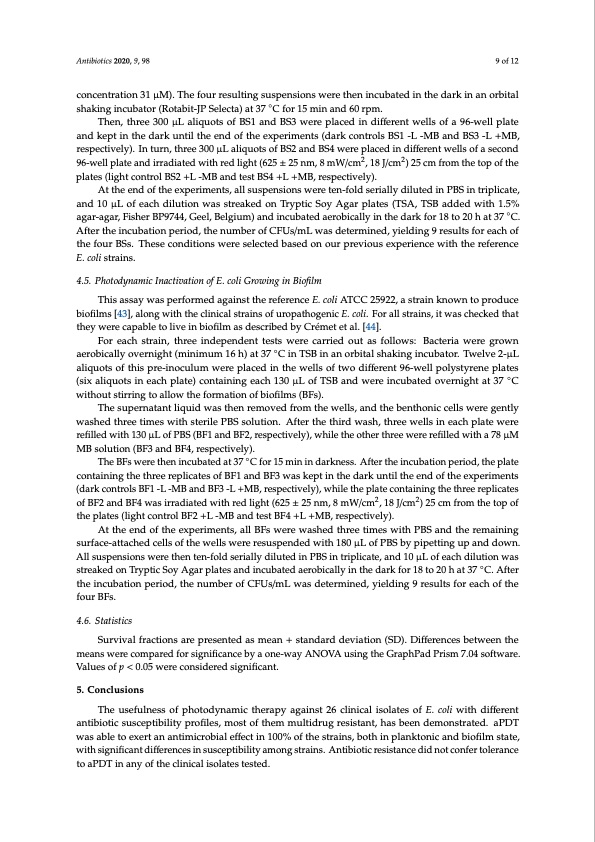
PDF Publication Title:
Text from PDF Page: 009
Antibiotics 2020, 9, 98 9 of 12 concentration 31 μM). The four resulting suspensions were then incubated in the dark in an orbital shaking incubator (Rotabit-JP Selecta) at 37 ◦C for 15 min and 60 rpm. Then, three 300 μL aliquots of BS1 and BS3 were placed in different wells of a 96-well plate and kept in the dark until the end of the experiments (dark controls BS1 -L -MB and BS3 -L +MB, respectively). In turn, three 300 μL aliquots of BS2 and BS4 were placed in different wells of a second 96-well plate and irradiated with red light (625 ± 25 nm, 8 mW/cm2, 18 J/cm2) 25 cm from the top of the plates (light control BS2 +L -MB and test BS4 +L +MB, respectively). At the end of the experiments, all suspensions were ten-fold serially diluted in PBS in triplicate, and 10 μL of each dilution was streaked on Tryptic Soy Agar plates (TSA, TSB added with 1.5% agar-agar, Fisher BP9744, Geel, Belgium) and incubated aerobically in the dark for 18 to 20 h at 37 ◦C. After the incubation period, the number of CFUs/mL was determined, yielding 9 results for each of the four BSs. These conditions were selected based on our previous experience with the reference E. coli strains. 4.5. Photodynamic Inactivation of E. coli Growing in Biofilm This assay was performed against the reference E. coli ATCC 25922, a strain known to produce biofilms [43], along with the clinical strains of uropathogenic E. coli. For all strains, it was checked that they were capable to live in biofilm as described by Crémet et al. [44]. For each strain, three independent tests were carried out as follows: Bacteria were grown aerobically overnight (minimum 16 h) at 37 ◦C in TSB in an orbital shaking incubator. Twelve 2-μL aliquots of this pre-inoculum were placed in the wells of two different 96-well polystyrene plates (six aliquots in each plate) containing each 130 μL of TSB and were incubated overnight at 37 ◦C without stirring to allow the formation of biofilms (BFs). The supernatant liquid was then removed from the wells, and the benthonic cells were gently washed three times with sterile PBS solution. After the third wash, three wells in each plate were refilled with 130 μL of PBS (BF1 and BF2, respectively), while the other three were refilled with a 78 μM MB solution (BF3 and BF4, respectively). The BFs were then incubated at 37 ◦C for 15 min in darkness. After the incubation period, the plate containing the three replicates of BF1 and BF3 was kept in the dark until the end of the experiments (dark controls BF1 -L -MB and BF3 -L +MB, respectively), while the plate containing the three replicates of BF2 and BF4 was irradiated with red light (625 ± 25 nm, 8 mW/cm2, 18 J/cm2) 25 cm from the top of the plates (light control BF2 +L -MB and test BF4 +L +MB, respectively). At the end of the experiments, all BFs were washed three times with PBS and the remaining surface-attached cells of the wells were resuspended with 180 μL of PBS by pipetting up and down. All suspensions were then ten-fold serially diluted in PBS in triplicate, and 10 μL of each dilution was streaked on Tryptic Soy Agar plates and incubated aerobically in the dark for 18 to 20 h at 37 ◦C. After the incubation period, the number of CFUs/mL was determined, yielding 9 results for each of the four BFs. 4.6. Statistics Survival fractions are presented as mean + standard deviation (SD). Differences between the means were compared for significance by a one-way ANOVA using the GraphPad Prism 7.04 software. Values of p < 0.05 were considered significant. 5. Conclusions The usefulness of photodynamic therapy against 26 clinical isolates of E. coli with different antibiotic susceptibility profiles, most of them multidrug resistant, has been demonstrated. aPDT was able to exert an antimicrobial effect in 100% of the strains, both in planktonic and biofilm state, with significant differences in susceptibility among strains. Antibiotic resistance did not confer tolerance to aPDT in any of the clinical isolates tested.PDF Image | Effective Photodynamic Inactivation of 26 E coli Strains

PDF Search Title:
Effective Photodynamic Inactivation of 26 E coli StrainsOriginal File Name Searched:
antibiotics-09-00098-v2.pdfDIY PDF Search: Google It | Yahoo | Bing
Cruise Ship Reviews | Luxury Resort | Jet | Yacht | and Travel Tech More Info
Cruising Review Topics and Articles More Info
Software based on Filemaker for the travel industry More Info
The Burgenstock Resort: Reviews on CruisingReview website... More Info
Resort Reviews: World Class resorts... More Info
The Riffelalp Resort: Reviews on CruisingReview website... More Info
| CONTACT TEL: 608-238-6001 Email: greg@cruisingreview.com | RSS | AMP |